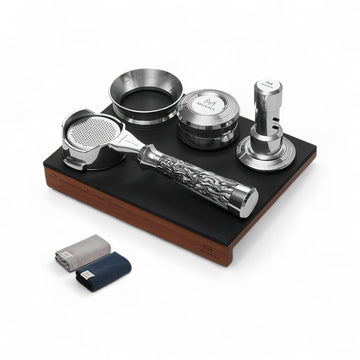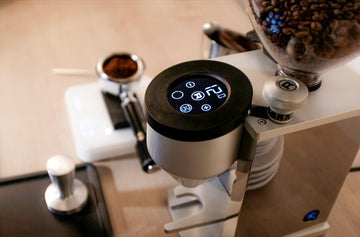If you are just getting deeper into Espresso brewing, you will be feeling tired about the number of grind and grind sizes. What type of grind is suitable for Espresso? You tend to buy pre-ground coffee beans instead of learning how to make your Espresso cups at home. However, hold on a few minutes and read this article first.
Discovering Espresso grinders
Espresso grinders play an important role in the quality of your coffee cup. For that reason, you should pay close attention to the types of grinders and the quality of them. They possibly impact your Espresso brewing process at the end.
Types of grinders
There are certainly two kinds of Espresso grinders – the blade and the burr ones.
- Blade grinders: these grinders use blades to crush coffee beans so that the coffee has fine particles. Although blade grinders have affordable price points, they produce erratic grind sizes that directly affect the extraction process. Therefore, blade grinders are less suitable for Espresso brewing.
- Burr grinders: these contain two rough surfaces that rub the coffee beans to persistent sizes. Burr grinders consist of two types – flat burr grinders and the conical burr ones. Both these kinds offer well grind sizes, but the conical burr ones are quieter motion and consume less heat. These factors impact the Espresso’s flavor. Hence, most baristas and Espresso aficionados prefer burr grinders for their coffee cups.
The quality of grinders
The quality of an Espresso grinder clouts the extraction process since it impacts the following points.
- Grind size: a rational and true grind size is vital for making Espresso. In other words, the extraction time and flavor of your Espresso cups could be affected by deviations in grind size. Premium grinders give a more stable grind, which supports the coffee getting a balanced and tasty shot.
- Grind adjustability: a high-quality Espresso grinder has a variety of grind size adjustments, helping a barista to change the grind size for good extraction. This is a basic requirement when making Espresso, as small adjustments possibly turn to positive differences in the taste of the final brew.
- Retention and dosing: a well-made grinder tends to have low retention. In other words, good grinders keep excess coffee grounds after grinding. It makes sure that each shot provides fresh coffee and increases the potential flavor. Furthermore, high-end grinders are equipped with true dosing mechanisms, allowing a barista to control the amount of coffee grounds for each shot.
Discovering and understanding the Espresso grinder categories and the necessity of grinder quality is crucial for anyone who would like to grind coffee beans for Espresso. Purchasing a premium grinder means that you monitor the extraction, the Espresso flavor, and the brewing process.
Why does coffee grind size matter to your Espresso?
The coffee method involves your Espresso. The coffee grind affects the exposed surface area of the grounds and the extraction. This is because the water from the espresso surface area runs fast at high pressure over the grounds. No matter the brew method, Espresso-making usually involves extracting flavor from the coffee grounds.
The finer you grind the Espresso coffee beans, the more you expand the exposed surface area of the coffee grounds, bringing out quicker extraction. Thus, Espresso makers have fine ground in order to help water rapidly move to the under at high pressure.
Grind sizes for every coffee brewing process
Adjusting grind size for a specific shot is a part of the brewing process at home. However, general grind size recommendations always exist for positive reasons. Generally speaking, some grinders often have labels on them showing different brew methods. If your maker does not denote it, you will need to follow a quick guide below.
- Espresso: it requires a slight coarser but keeps the coffee fine on the surface. Because the brew time is very fast and short, fine particles can meet the time. Additionally, a consistent brewing process impacts on the water. Espresso is often brewed under high pressure, boosting the extraction speed. However, the fine ground might push those grinds close together, resulting in the pressurized water shooting to the coffee bed hurriedly.
- Pour over and automatic drip brewer: for small and single-serve pour overs, you tend to go a little finer. This is because you will use less water, it could be hard to increase the brew time. The finer rind will facilitate the extraction immediately. Moreover, the refusal from the finer coffee grounds will let the water drip more deliberately. If you are brewing a gallon and a half of coffee at the same time, for instance, grind your coffee to medium-coarse. Please keep in mind that you should not extract the coffee too much or prevent the water from going through.
- French Press: if you want to enjoy this shot, you will grind the coffee bean coarsely. It helps the extraction be consistent and the water can sit there. The filter of the French Press might permit several small particles to go through if the coffee bean ground too fine.
- Turkish coffee: Turkish coffee requires the coffee ground to be as fine as possible. This is because smooth particles create the main taste of your coffee. Also, the coffee grounds can contact hot water for a short part of the brewing time. In other words, small particles are the main parts of the extraction speed.
- Cold brew: if you feel too bitter when trying Espresso and other types, then you will taste this brew method. Cold brew coffee requires cold water and a long brew period to extract the coffee beans. You need to use coarse ground coffee and steep them in cool water for at least 12 hours. Remember to separate coffee grounds. Then, you could top the coffee up with cold water till you get the right taste. Enjoy your coffee cup with ice or hot water.
Factors to take into account when looking for the grind size
An Espresso cup usually has a rich and dark coffee. It is brewed at about 9 bars of coffee bean pressure. So, your coffee is full of flavor extraction in a short time. To get the right Espresso taste, you will need to focus on the grind size and its factors.
- Espresso recipe: how much ground coffee do you want to use? Adjusting the dose also impacts how fast or slowly the water flows through the coffee. A high dose, for instance, will prevent the water flow. In other words, Espresso requires a coarser grind size. By using a coarser grind, the coffee and water flows faster and avoids over-extracting.
- Types of coffee beans: not every coffee bean has the same condition and quality. Altitude, the region of harvest and produce, and processing of the coffee beans you are going to use, will play crucial roles on the grind size and coffee quality.
- Roast style: over time, built-in grinders tend to work great with medium and medium-dark roasts. The dial process could be tricky until you make a balanced Espresso cup without acidic taste.
- Water: the accurate water temperature for brewing any type of hot coffee ranges from 195 to 205 degrees of Fahrenheit. Most Espresso devices often do it for you, but if you feel bitter in your cups, then you could check your coffee maker again. The water might be too hot. Another solution to reduce the bitter in your Espresso is that you can insert a water filter at the inlet of your plumbed coffee maker.
How often should you grind Espresso to keep it fresh?
To enjoy the freshest flavor, you should grind the coffee beans every time you brew the coffee. Coffee particularly starts to lose flavor about 15 minutes after grinding. To hold your coffee fresh, you will grind the right amount of coffee you need before brewing.
Final words
Learning how to grind coffee beans and the number of grinders for your Espresso do not have to be ambitious. With the help of this guide, you probably find the right size with confidence. Are you ready to make your coffee cup?













